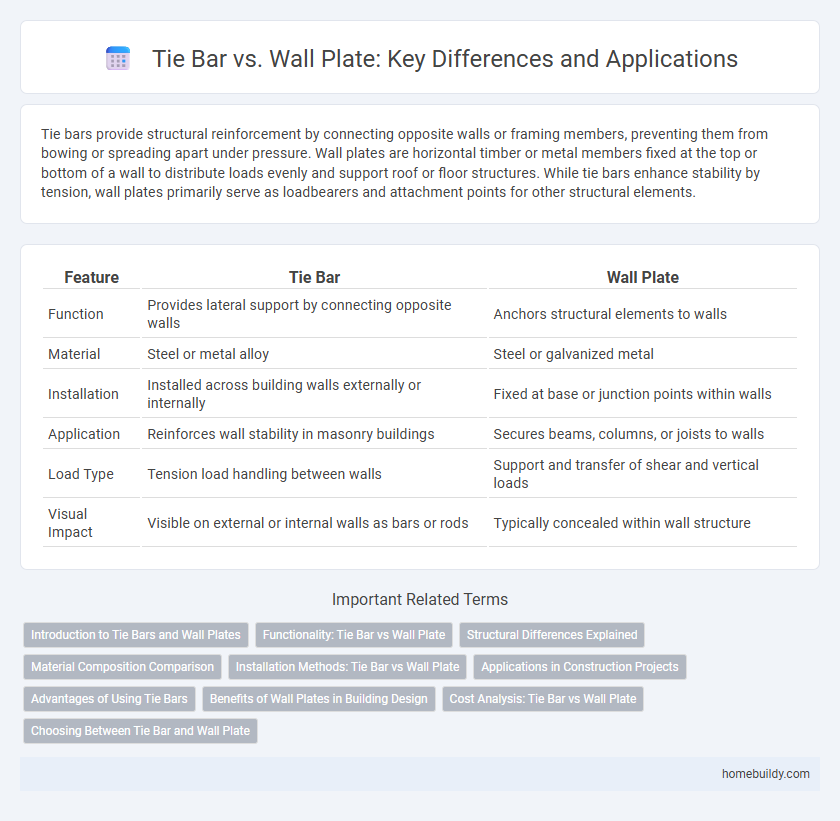Tie bars provide structural reinforcement by connecting opposite walls or framing members, preventing them from bowing or spreading apart under pressure. Wall plates are horizontal timber or metal members fixed at the top or bottom of a wall to distribute loads evenly and support roof or floor structures. While tie bars enhance stability by tension, wall plates primarily serve as loadbearers and attachment points for other structural elements.
Table of Comparison
| Feature | Tie Bar | Wall Plate |
|---|---|---|
| Function | Provides lateral support by connecting opposite walls | Anchors structural elements to walls |
| Material | Steel or metal alloy | Steel or galvanized metal |
| Installation | Installed across building walls externally or internally | Fixed at base or junction points within walls |
| Application | Reinforces wall stability in masonry buildings | Secures beams, columns, or joists to walls |
| Load Type | Tension load handling between walls | Support and transfer of shear and vertical loads |
| Visual Impact | Visible on external or internal walls as bars or rods | Typically concealed within wall structure |
Introduction to Tie Bars and Wall Plates
Tie bars provide structural reinforcement by connecting two concrete elements to prevent movement and improve stability, commonly used in retaining walls and masonry structures. Wall plates serve as a base or support layer to distribute loads evenly across framing components and anchor wooden or steel structures to masonry or concrete foundations. Both tie bars and wall plates play crucial but distinct roles in ensuring the durability and strength of building frameworks.
Functionality: Tie Bar vs Wall Plate
Tie bars provide structural stability by directly reinforcing concrete panels and preventing lateral movement, making them essential in load-bearing wall systems. Wall plates distribute loads evenly across a broader surface area and serve as anchor points for ceiling or roof structures, enhancing overall frame integrity. The functionality of tie bars centers on tension resistance, while wall plates primarily focus on load distribution and connection support.
Structural Differences Explained
Tie bars and wall plates differ fundamentally in their structural roles and compositions; tie bars are typically slender, tension-bearing metal rods designed to hold walls or structural elements together, preventing lateral movement. Wall plates are broader, flat timber or metal components fixed atop walls, serving as a base for roof trusses or other loads, distributing forces evenly across the wall surface. While tie bars resist tensile forces, wall plates primarily function in load distribution and anchorage for upper structural elements.
Material Composition Comparison
Tie bars are typically made from high-strength steel alloys that provide superior tensile strength and corrosion resistance, which is essential for structural support in construction. Wall plates, often fabricated from galvanized steel or aluminum, offer durability but may lack the tensile capacity found in tie bars. The choice between tie bars and wall plates depends on the specific load-bearing requirements and environmental conditions, with material composition playing a crucial role in performance and longevity.
Installation Methods: Tie Bar vs Wall Plate
Tie bars are installed by embedding them within concrete walls or floors, creating a strong internal connection that enhances structural stability. Wall plates are surface-mounted components attached externally to walls using anchors or screws, offering easier access but less integral reinforcement. Installation of tie bars typically requires precise positioning during construction, while wall plates allow for more flexible and quicker retrofit applications.
Applications in Construction Projects
Tie bars provide crucial lateral support in construction projects, especially in retaining walls and basement structures, by tying opposing walls to resist soil pressure. Wall plates serve as horizontal support components in timber framing, distributing loads from roof trusses or floor joists to vertical studs or walls. Tie bars are preferred for heavy-duty reinforcement in concrete or masonry, while wall plates are primarily used in wood-framed buildings for load transfer and structural stability.
Advantages of Using Tie Bars
Tie bars offer superior structural support by evenly distributing loads across beams, reducing deflection and enhancing overall stability. They provide easier installation and adjustment compared to wall plates, allowing for precise alignment in construction projects. Tie bars also ensure improved resistance to lateral forces, making them ideal for securing framework in seismic or high-wind areas.
Benefits of Wall Plates in Building Design
Wall plates offer enhanced load distribution in building design, reducing stress on structural elements compared to tie bars. They improve aesthetic integration by concealing fasteners and connections, providing a cleaner, more finished appearance. Wall plates also allow for easier adjustments and repairs, increasing the building's flexibility and long-term durability.
Cost Analysis: Tie Bar vs Wall Plate
Tie bars generally offer a more cost-effective solution compared to wall plates due to lower material and installation expenses. Wall plates often require more labor-intensive mounting and additional hardware, increasing overall project costs. Evaluating long-term durability and maintenance also reveals tie bars typically demand fewer repairs, further enhancing their economic advantage.
Choosing Between Tie Bar and Wall Plate
Choosing between a tie bar and a wall plate depends on the specific structural requirements and load distribution of the building. Tie bars provide superior tension resistance by directly connecting structural elements, making them ideal for reinforcing walls against lateral forces. Wall plates serve as anchoring points for tie bars but offer less flexibility in load transfer and are better suited for distributing loads across a broader area.
Tie bar vs Wall plate Infographic

 homebuildy.com
homebuildy.com